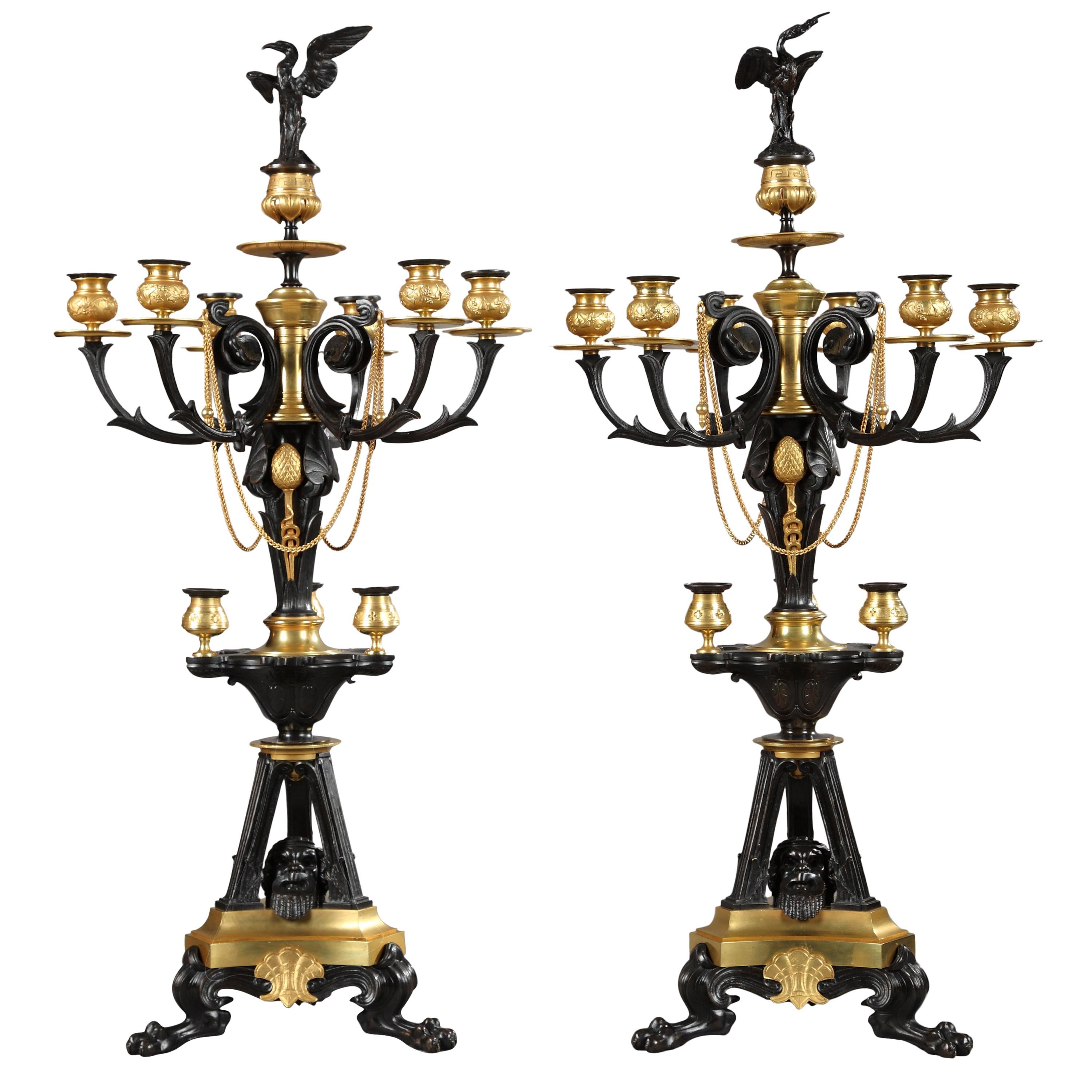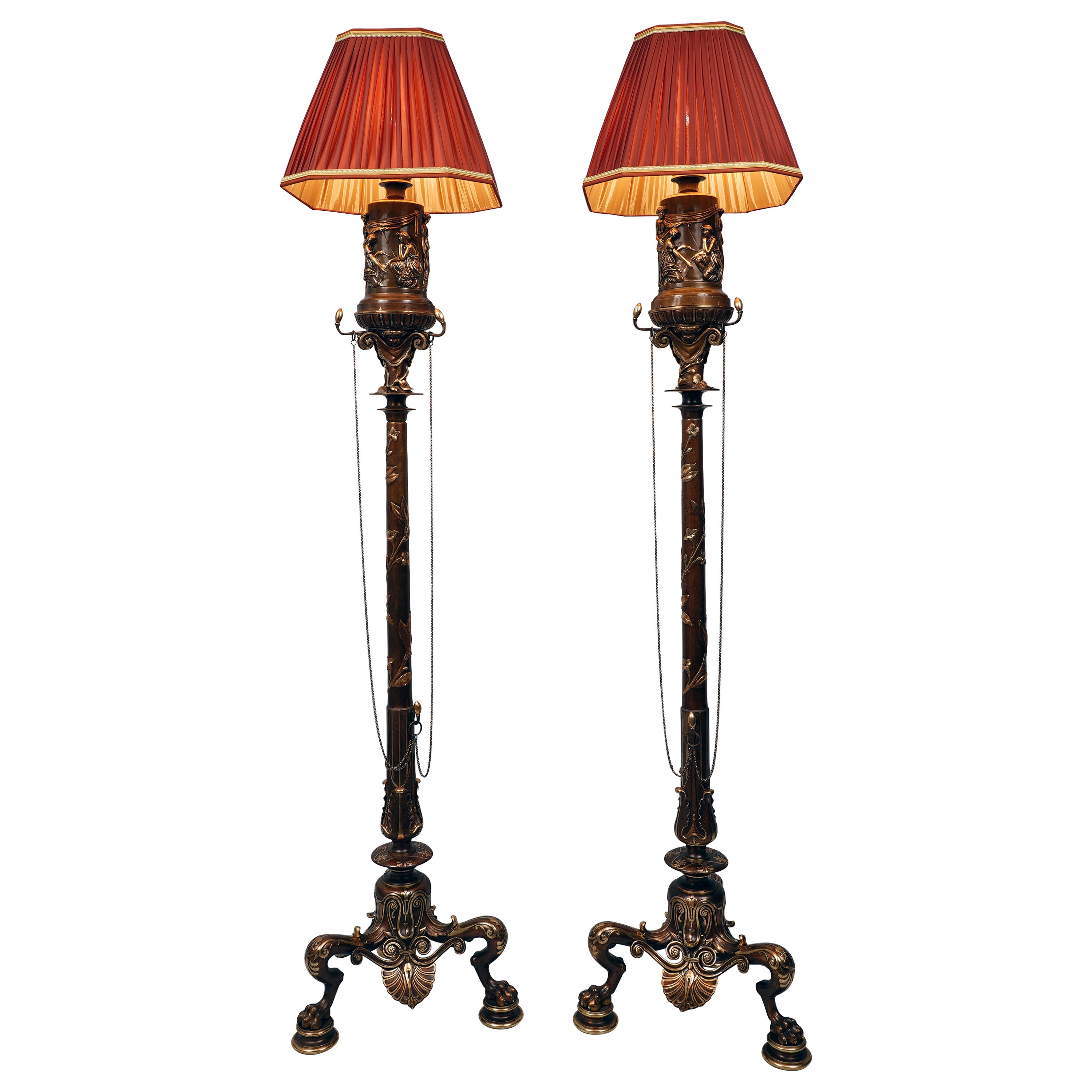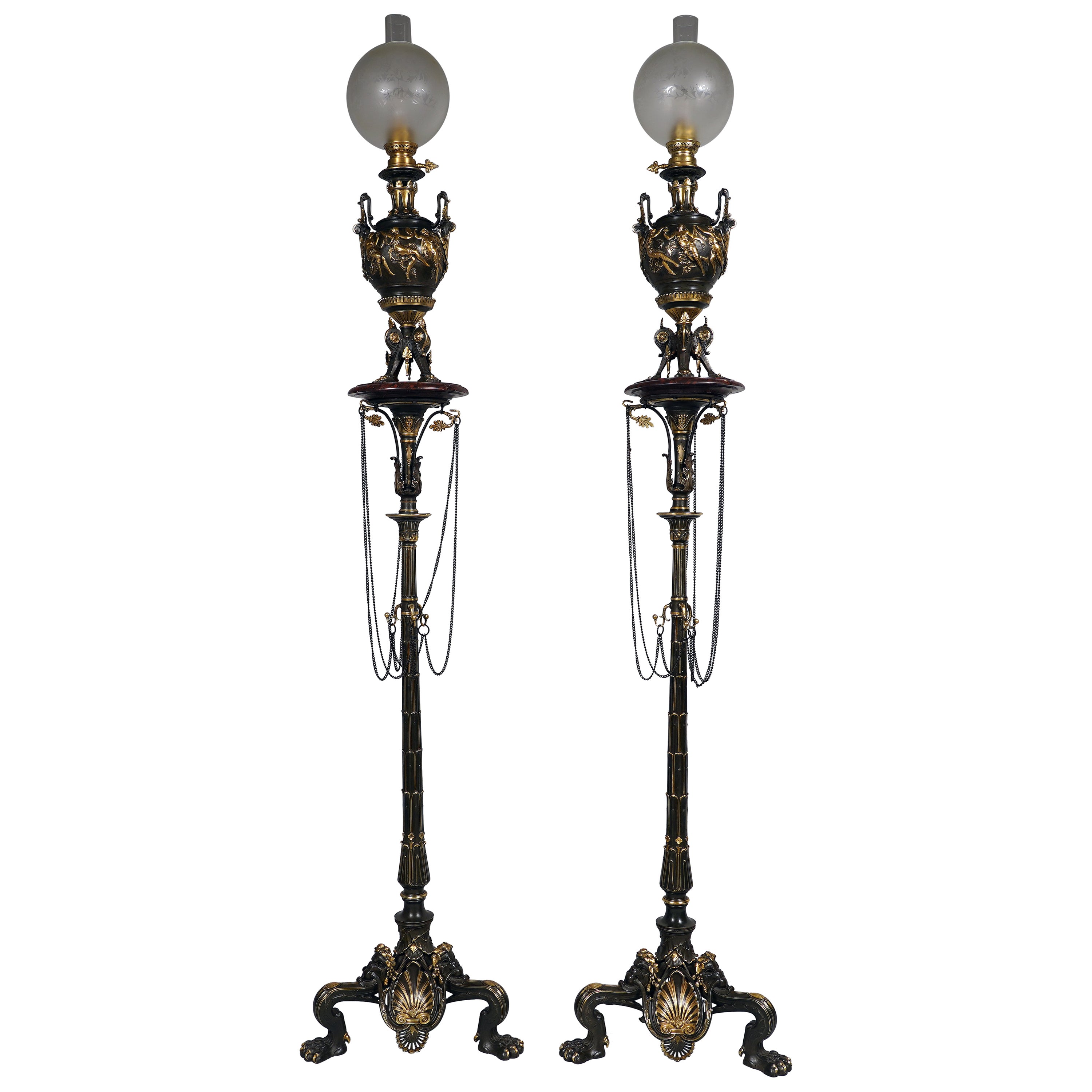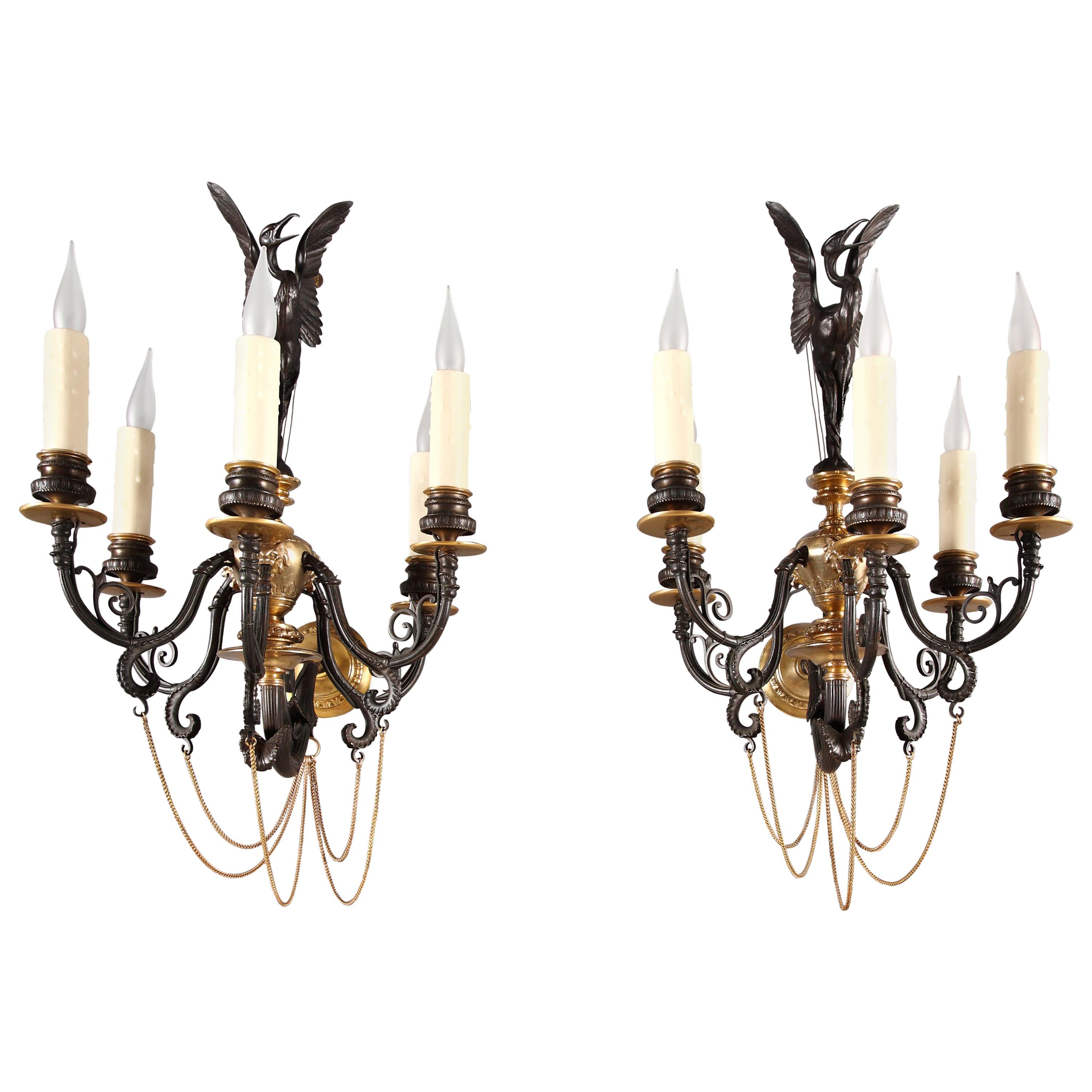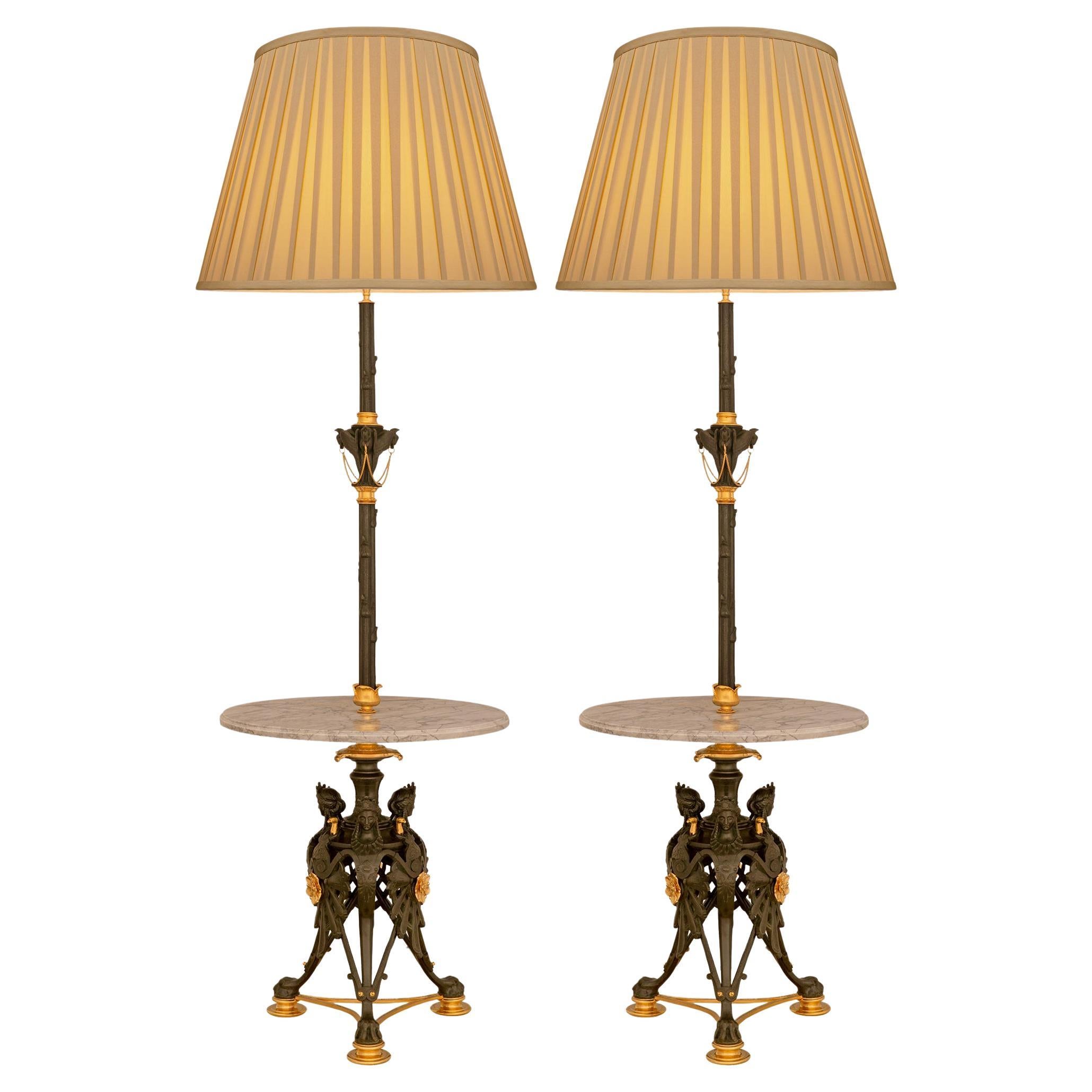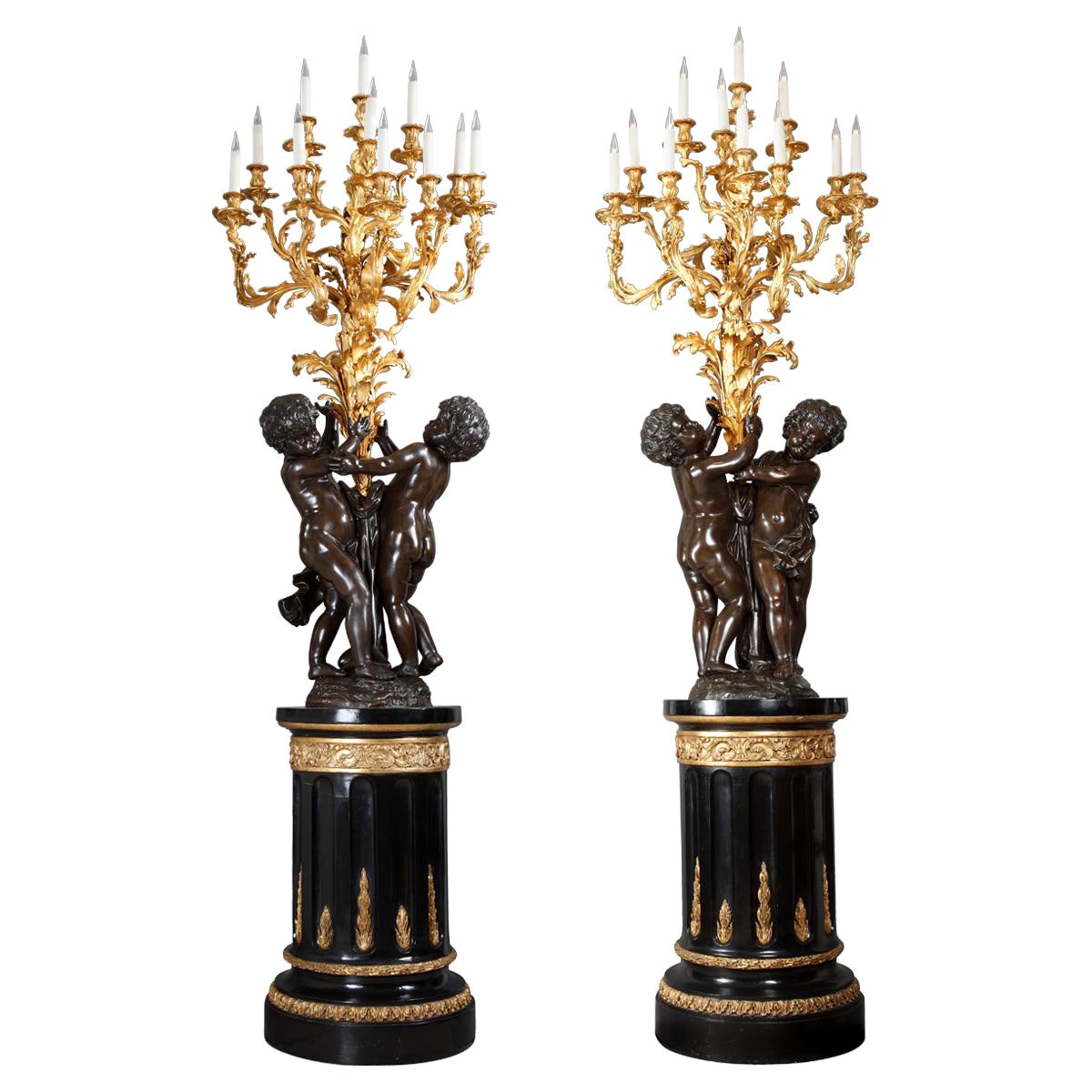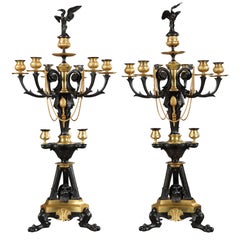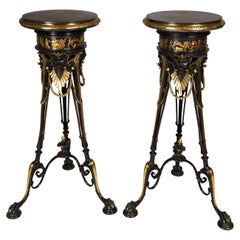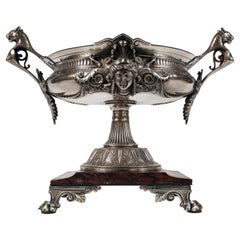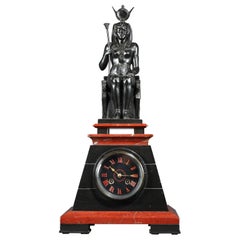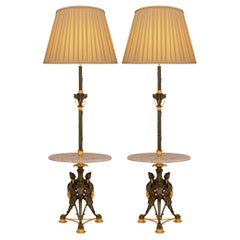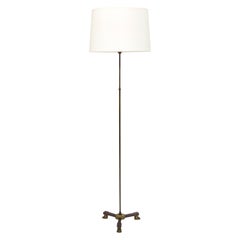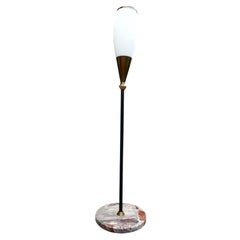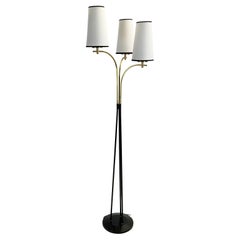Items Similar to Pair of Neo-Greek Floor Lamps Attributed to G. Servant, France, Circa 1870
Want more images or videos?
Request additional images or videos from the seller
1 of 9
Pair of Neo-Greek Floor Lamps Attributed to G. Servant, France, Circa 1870
About the Item
Rare pair of Greek style floor lamps made in patinated bronze attributed to G. Servant, each surmounted of a frosted glass globe engraved of stars and a Greek motif frieze. The body of the vase, decorated with Greek style patterns such as palmets, Greek motif frieze and water leaves, stands on a shaft decorated with deer heads. Fine chains are connected to a delicate butterfly. The set is based on tripod legs with lion claw feet alternating large palmets.
Height : 183 cm (72 in.) ; 213 cm (83 3/4 in.) with glass shades ; Diameter : 43 cm (19 2/3in.)
Georges Emile Henri Servant (1828-c.1890), who took over his father in 1855 at their foundry, rue Vieille-du-Temple, in Paris, specialized in the production of neo-Egyptian style clocks, very popular in France since 1860’s, and also the making of Greek style decorative objects. He drew considerable attention to the high quality of his bronzes at the 1855 Paris Universal Exhibition and then at the 1862 London Exhibition. At this time Servant exported up to 40% of his production, principally to the United States, where for instance, his clocks were sold with great success by Louis Tiffany Inc. or Hamann & Roche of New York. But his success came really at the 1867 Paris Universal Exhibition, where he was awarded a gold medal for his neo-Greek and Egyptian works (Les Merveilles de l’Exposition Universelle de 1867, t. II, p° 165 & 167). He was even awarded in 1874 the « Ordre national de la Légion d’Honneur », France’s hightest official mark of recognition. Servant participated once again successfully at the 1878 Paris Universal Exhibition, where he not only exhibited vases and small bronze pieces of furniture, but was also a member of the jury for the class of bronze pieces of art. He finally retired shortly before the 1889 Paris Universal Exhibition.
- Attributed to:Georges Emile Henri Servant (Maker)
- Dimensions:Height: 83.86 in (213 cm)Diameter: 16.93 in (43 cm)
- Sold As:Set of 2
- Style:Greek Revival (In the Style Of)
- Materials and Techniques:
- Place of Origin:
- Period:
- Date of Manufacture:circa 1870
- Condition:Wear consistent with age and use.
- Seller Location:PARIS, FR
- Reference Number:Seller: 12941stDibs: LU3860318759832
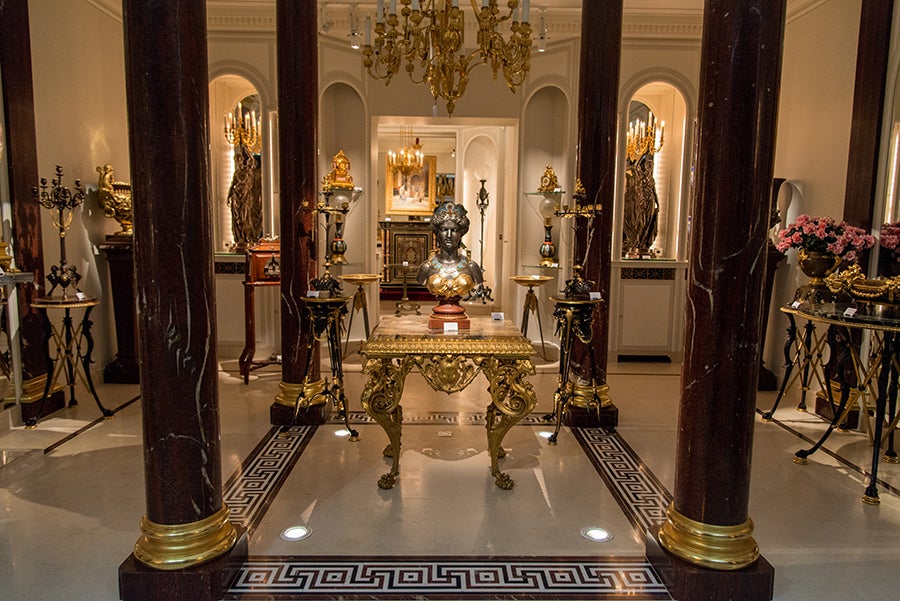
About the Seller
4.9
Gold Seller
Premium sellers maintaining a 4.3+ rating and 24-hour response times
Established in 1997
1stDibs seller since 2018
85 sales on 1stDibs
Typical response time: 1 hour
Associations
International Confederation of Art and Antique Dealers' Associations
- ShippingRetrieving quote...Shipping from: PARIS, France
- Return Policy
Authenticity Guarantee
In the unlikely event there’s an issue with an item’s authenticity, contact us within 1 year for a full refund. DetailsMoney-Back Guarantee
If your item is not as described, is damaged in transit, or does not arrive, contact us within 7 days for a full refund. Details24-Hour Cancellation
You have a 24-hour grace period in which to reconsider your purchase, with no questions asked.Vetted Professional Sellers
Our world-class sellers must adhere to strict standards for service and quality, maintaining the integrity of our listings.Price-Match Guarantee
If you find that a seller listed the same item for a lower price elsewhere, we’ll match it.Trusted Global Delivery
Our best-in-class carrier network provides specialized shipping options worldwide, including custom delivery.More From This Seller
View AllPair of Neo-Greek Bronze Candelabras Attributed to G.Servant, France, Circa 1870
By Georges Emile Henri Servant
Located in PARIS, FR
Rare pair of Greek style candelabras made in patinated bronze and gilded bronze, attributed to G. Servant. Each with ten light arms topped by a heron shaped extinguisher. Decorated with various Greek style motifs such palmets, pine cones ans water leaves. Standing on a small triangular architecture presenting a theatre mask and reposing on a tripod base formed with lion paw feet.
Georges Emile Henri Servant (circa 1828-1890), who took over his father in 1855 at their foundry, rue Vieille-du-Temple, in Paris, specialized in the production of neo-Egyptian style clocks, very popular in France since 1860’s, and also the making of Greek style decorative objects. He drew considerable attention to the high quality of his bronzes at the 1855 Paris Universal Exhibition and then at the 1862 London Exhibition. At this time Servant exported up to 40% of his production, principally to the United States, where for instance, his clocks were sold with great success by Louis Tiffany Inc. or Hamann & Roche of New York. But his success came really at the 1867 Paris Universal Exhibition, where he was awarded a Gold Medal for his neo-Greek and Egyptian works (Les Merveilles...
Category
Antique 1870s French Greek Revival Table Lamps
Materials
Bronze
$7,823 Sale Price / set
62% Off
Pair of Neo-Greek Pedestals, attributed to G.Servant, France, Circa 1880
By Georges Emile Henri Servant
Located in PARIS, FR
Pair of patinated and gilded bronze turntable pedestals with for each of them, three paw feet, headed by stylized lion muzzles, ornated with beaded chains and joined by a fine foliate stretcher. The belt is adorned by a banded frieze cast in low-relief representing an ancient scene : “The Battle of the Lapithes and the Centaurs”.
These pedestals can be associated with the "Vases de Bacchus", presented by G. Servant at the 1867 Exposition Universelle, on which the similar ornamentation is applied.
(Reproduced in « Merveilles de l'Exposition Universelle de 1867 », Jules Mesnard, p°167)
Biography :
Georges Emile Henri Servant...
Category
Antique 1880s French Greek Revival Pedestals
Materials
Bronze
Neo-Greek Silvered Bronze Bowl Attributed to G. Servant, France, circa 1880
By Georges Emile Henri Servant
Located in PARIS, FR
Beautiful silvered bronze neo-Greek style bowl in a circular shape, adorned on the body with female masks in the antique style and on the sides with handles in the shape of busts of ...
Category
Antique 1880s French Greek Revival Decorative Bowls
Materials
Griotte Marble, Bronze
Neo-Egyptian Marble Clock Attributed to G. Servant, France, Circa 1870
By Georges Emile Henri Servant
Located in PARIS, FR
Black and red marble pyramid shaped Egyptian style clock attributed to G. Servant, surmounted by a patinated bronze figure representing the Egyptian goddess Isis sitting on her throne. Wearing the Hathor hairdress (the solar disc surrounded by the sacred cow horns), she holds in her right hand the Ouadj, the goddesses scepter surmounted by a canopy of papyrus, symbolizing health and eternal youth and in her left hand, the cross of life Ankh, symbol of rebirth and eternity.
That Egyptian style in fashion since Napoleon the First and his military campaigns in Egypt around 1799 was rediscovered in France in the 1830's and above all in the 1860's. Some renowned French artists, such the sculptors and bronze-casters Guillaume Denière (1815-1903), Emile Hébert (1828-1893) et Georges Servant (1828-1890), presented at the 1867 and 1878 Paris Universal Exhibitions, an a-part section dedicated to their Egyptian style production. Their shows drew then considerable attention from the public and the wealthy collectors. During the 1867 Universal Exhibition, one could admire the Stand realized by the French silversmith-jeweller Gustave Baugrand (1826-1870), where his works executed in most Fine materials took inspiration from the Egyptian Antiques, exhibited then in the Louvre museum.
Georges Emile Henri Servant (1828-c.1890), who took over his father in 1855 at their foundry, rue Vieille-du-Temple, in Paris, specialized in the production of neo-Egyptian style clocks, very popular in France since 1860’s, and also the making of Greek style decorative objects. He drew considerable attention to the high quality of his bronzes at the 1855 Paris Universal Exhibition and then at the 1862 London Exhibition. At this time Servant exported up to 40% of his production, principally to the United States, where for instance, his clocks were sold with great success by Louis Tiffany Inc. or Hamann & Roche of New York. But his success came really at the 1867 Paris Universal Exhibition, where he was awarded a gold medal for his neo-Greek and Egyptian works (Les Merveilles...
Category
Antique 1870s French Egyptian Revival Table Clocks and Desk Clocks
Materials
Marble, Bronze
Pair of Neo-Greek Bronze Floor Lamps by F. Barbedienne, France, circa 1860
By Ferdinand Barbedienne
Located in PARIS, FR
Height without/with lampshade : 168/185 cm (66,1 / 72,8 in.) ; Base : 43 x 43 cm (16,9 x 16,9 in.)
Beautiful pair of neo-Greek floor lamps in bronze with double patina, composed of cylindrical lamps, decorated on the body with a rotating frieze representing women dressed in the Antique style weaving and spinning, surmounted by lampshades with cut sides in red pleated silk with golden braid.
They are placed on pedestals from which hang thin chains attached to the slender shaft decorated with stylized leaves and flowers, resting on a tripod base decorated with large palmettes and ending in lion’s paws.
The stylistic repertoire used here, composed in particular of palmettes, masks, and nymphs, evokes Greek Antiquity, as does the reuse of forms of furniture and objects such as tripods and antique vases.
The rediscovery in the 18th century of the archaeological remains of Pompeii and Herculaneum allowed artists of all disciplines to draw inspiration from Antiquity while reinterpreting it.
This trend did not fade and, in the 19th century, many personalities fitted out their interiors with neo-Greek furniture, as was the case for the Maison Pompéienne built in 1856 by the architect Alfred Normand (1822-1909) for Prince Napoleon, or Empress Eugénie who bought from the Maison Barbedienne pedestals inspired by antique tripods.
Related work :
Pedestal model presented by Maison Barbedienne at the Universal Exhibition in Paris in 1855. On this occasion, Empress Eugénie bought it for her bathroom in the Château de Saint-Cloud. This model pleased the Empress so much that she ordered two other pairs in 1858 for her boudoir in the palaces of Compiègne and Fontainebleau. (see photo attached)
Photo showing a floor lamp similar to ours in Empress Eugénie’s bedroom in the Château de Compiègne (Oise), in Architecture intérieure et Décoration en France des...
Category
Antique 1860s French Greek Revival Floor Lamps
Materials
Bronze
Pair of Neo-Greek Floor Lamps Att. to Lacarrière, Delatour & Cie, France, C 1860
By Lacarrière, Delatour and Co.
Located in PARIS, FR
Measures : Total Height : 188,5 cm (74,2 in.) ; Base : 45 x 45 cm (17,7 x 17,7 in.)
Pedestal height : 136 cm (53,5 in.)
Lamp height : 52 cm (20,4 in.)
Beautiful pair of neo-Greek fl...
Category
Antique 1860s French Greek Revival Floor Lamps
Materials
Griotte Marble, Bronze
You May Also Like
pair of French 19th century Neo-Greek st. Bronze, Ormolu and Marble tables/lamps
Located in West Palm Beach, FL
A rare and most unique pair of French 19th century Neo-Greek st. Patinated Bronze, Ormolu and Arabescato marble side tables/floor lamps. Each impressive side table/floor lamp is rais...
Category
Antique 19th Century French Greek Revival Floor Lamps
Materials
Marble, Bronze, Ormolu
Lion Feet Bronze Neo Classical Floor Lamp Attributed to Arbus, France 1940's
By André Arbus
Located in New York, NY
Rare patinated bronze lamp floor.
Attributed to André Arbus.
Height adjustable from 45" to 59" excluding shade.
Shade for showing purposes only.
...
Category
Vintage 1940s French Neoclassical Floor Lamps
Materials
Bronze
Floor lamp attributed to Stilnovo
By Stilnovo
Located in Lugo, IT
Floor lamp attributed to Stilnovo, 1960
Brass, marble, and opal glass.
Measures 103 cm by 11.5/25 cm
Good Condition
Thank you
Category
Vintage 1960s Italian Mid-Century Modern Floor Lamps
Materials
Marble, Brass
1950s Floor Lamp Attributed to Maison Lunel France
By Maison Lunel
Located in London, GB
1950s floor lamp attributed to Maison Lunel France.
The circular base is painted black with a polished brass arm finish.
Each of the arms is topped with a parchment shade with a bl...
Category
Mid-20th Century French Mid-Century Modern Floor Lamps
Materials
Metal, Brass
$1,696 Sale Price
20% Off
Mid-Century Pair of Standing Floor Lamps Attributed to Magistrettiaa
By Vico Magistretti
Located in Water Mill, NY
Mid-Century pair of heavy standing chrome and iron floor lamps with acrylic shades and chrome finials with floor puch, on/off switch.
Category
Vintage 1960s Floor Lamps
Materials
Chrome, Iron
Pair of Wrought Iron Floor Lamps Attributed to Samuel Yellin
By Samuel Yellin
Located in New York, NY
Whimsical pair of Wrought Iron floor lamps, attributed to master blacksmith Samuel Yellin. The pair of floor lamps are comprised of two parts: a hanging lantern with functional wirin...
Category
Early 20th Century American Art Deco Floor Lamps
Materials
Iron, Wrought Iron
Recently Viewed
View AllMore Ways To Browse
Greek Style Lamp
Greek French Lamps
Lamp Made Of Chain
Over Head Lighting
Antique Lamps 1870
Antique Lighting London
Antique Lamp Stand Antiques
Butterflyly Lamp
Lamp With Butterflies
Rual Georges
Temple Lamp
Bronze Globe Lamp
Lamps Pair London
Egypt Lamps
Lamp Egypt
Lamps By Tiffany
Pair Small Bronze Lamps
Bronze Lion Lamps
